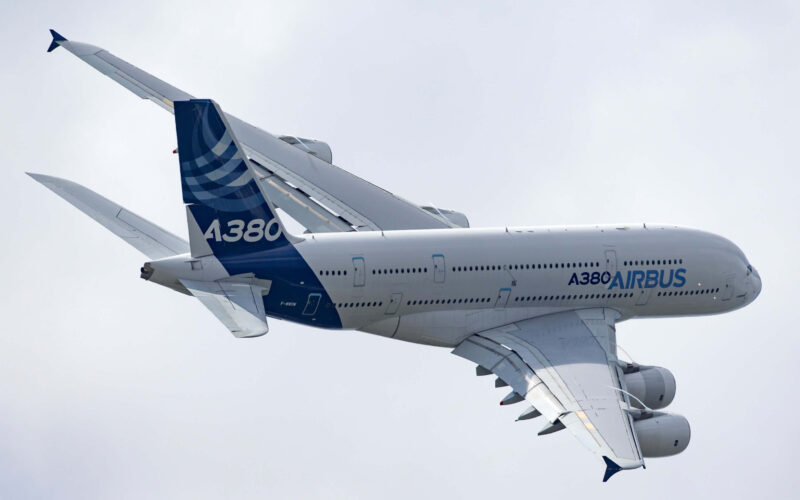Airbus A380 aircraft can be seen flying over various African countries including South Africa, Egypt and Algeria. But not one of the plane’s carriers is, or has been, based or registered in Africa. AeroTime investigates why African airlines have never flown the giant of the skies.
It all depends on the infrastructure…
Most of Africa’s full-service carriers (FSC) have chosen to stick with smaller and more agile wide-body aircraft such as Boeing 787 Dreamliners, Boeing 777s or Airbus A350s. Why has the largest passenger jet, the Airbus A380, been left out?
The Airbus A380 was built to serve as a large capacity jet to transport passengers long distances from concentrated hubs. But it can only be used on select routes which have the necessary demand and can accommodate the aircraft.
According to the International Civil Aviation Organization (ICAO), the Airbus A380 can operate scheduled flights in airports which have the Aerodrome Reference Code F. These airports have runways which allow for aircraft with massive wingspan and outer landing gear, usually the A380, Boeing 747-8 or Antonov An-225 Mriya.
The A380 aircraft is 80 meters wide and 73 meters long and is almost the length of a football field. Therefore, the sheer size of aircraft like the A380 require sophisticated airport infrastructure, including a wider and longer runway for take off and landing.
According to Airbus, the A380 is able to operate regular scheduled flights in 140 airports across the world. In addition, the manufacturer says that the carriers are capable of operating the A380 not only from Code F but also from Code E airports “with minimal changes to infrastructure and ground handling equipment”.
For instance, one of the most popular hubs for the A380, London Heathrow Airport (LHR), has invested £450 million ($611 million) to ensure it can handle the aircraft. Meanwhile, New York’s John F. Kennedy Airport (JFK) has invested more than $109 million in infrastructure for the A380, according to data presented in a report by Peter Forsyth, ‘Airport Infrastructure for the Airbus A380: Cost Recovery and Pricing’.
The well-known double-decker can accommodate more than 500 passengers in a typical three-class configuration. This requires more time for boarding, more ground handling equipment, and more staff to serve the aircraft. The airport also needs more gate space and dual passenger boarding bridges for the upper and lower decks of the A380.
Thus, many airports are not equipped to cope with such a large aircraft. Only a handful of Africa’s aviation hubs, namely in South Africa, Egypt or Mauritius, have such capabilities, meaning that only a few African FSCs can operate them from their respective hubs.
…and operational costs
Even before the end of production, the Airbus A380 was one of the most expensive jets ever built, valued at $445.6 million at a list price.
“The A380 is a high-risk plane to operate because of costs,” aviation analyst Desmond Latham tells AeroTime in an emailed statement.
Only 16 operators have operated the Airbus A380 aircraft, including carriers from Asia-Pacific, Europe, Australia, and the Middle East. However, none of the African, North and South American airlines ever flew the aircraft.
Latham says: “The volume of passengers in Africa was only really viable from South Africa and pre-2017/18 by SAA which is now a small airline that has been poorly managed by the state here in South Africa. No other African region including Ethiopia could support such a high-volume demand plane because of the high risk in dollar terms.”
Having the largest aircraft fleet in the continent, Ethiopian Airlines proved to be one of the most successful full-service carriers in Africa. But even for them, the A380 was not viable because it “operates Boeings mainly so it would entail retraining and an entire new ethos in terms of ownership and operations”, according to Latham.
“The A380 costs around $26,000 an hour to operate and its pax capacity is 500-525 pax. Only the big global players can afford that kind of money and volume of pax,” Latham explains. “The Boeing 737-800, the most popular plane in the world, costs $2,500 per hour and carries around 170 pax just to give you an idea about what we’re talking about here.”
Has the ship already sailed?
With A380 production already over, African airlines might be too late to join the game, even if they wanted to.
However, according to Latham, there might be a slim chance for African airlines to begin operating the super jumbos once their residual value is down. “But don’t hold your breath.”
He adds: “All airlines now are focusing on the single aisle aircraft, which is much more economical to operate, so there’s a belief that the A380 will be flown by BA [British Airways] and Emirates amongst others but unlikely by any African airline.”

